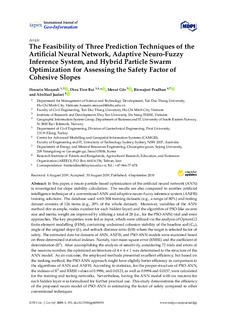| dc.description.abstract | In this paper, a neuro particle-based optimization of the artificial neural network (ANN) is investigated for slope stability calculation. The results are also compared to another artificial intelligence technique of a conventional ANN and adaptive neuro-fuzzy inference system (ANFIS) training solutions. The database used with 504 training datasets (e.g., a range of 80%) and testing dataset consists of 126 items (e.g., 20% of the whole dataset). Moreover, variables of the ANN method (for example, nodes number for each hidden layer) and the algorithm of PSO-like swarm size and inertia weight are improved by utilizing a total of 28 (i.e., for the PSO-ANN) trial and error approaches. The key properties were fed as input, which were utilized via the analysis of OptumG2 finite element modelling (FEM), containing undrained cohesion stability of the baseline soil (Cu), angle of the original slope (β), and setback distance ratio (b/B) where the target is selected factor of safety. The estimated data for datasets of ANN, ANFIS, and PSO-ANN models were examined based on three determined statistical indexes. Namely, root mean square error (RMSE) and the coefficient of determination (R2). After accomplishing the analysis of sensitivity, considering 72 trials and errors of the neurons number, the optimized architecture of 4 × 6 × 1 was determined to the structure of the ANN model. As an outcome, the employed methods presented excellent efficiency, but based on the ranking method, the PSO-ANN approach might have slightly better efficiency in comparison to the algorithms of ANN and ANFIS. According to statistics, for the proper structure of PSO-ANN, the indexes of R2 and RMSE values of 0.9996, and 0.0123, as well as 0.9994 and 0.0157, were calculated for the training and testing networks. Nevertheless, having the ANN model with six neurons for each hidden layer was formulized for further practical use. This study demonstrates the efficiency of the proposed neuro model of PSO-ANN in estimating the factor of safety compared to other conventional techniques | nb_NO |

